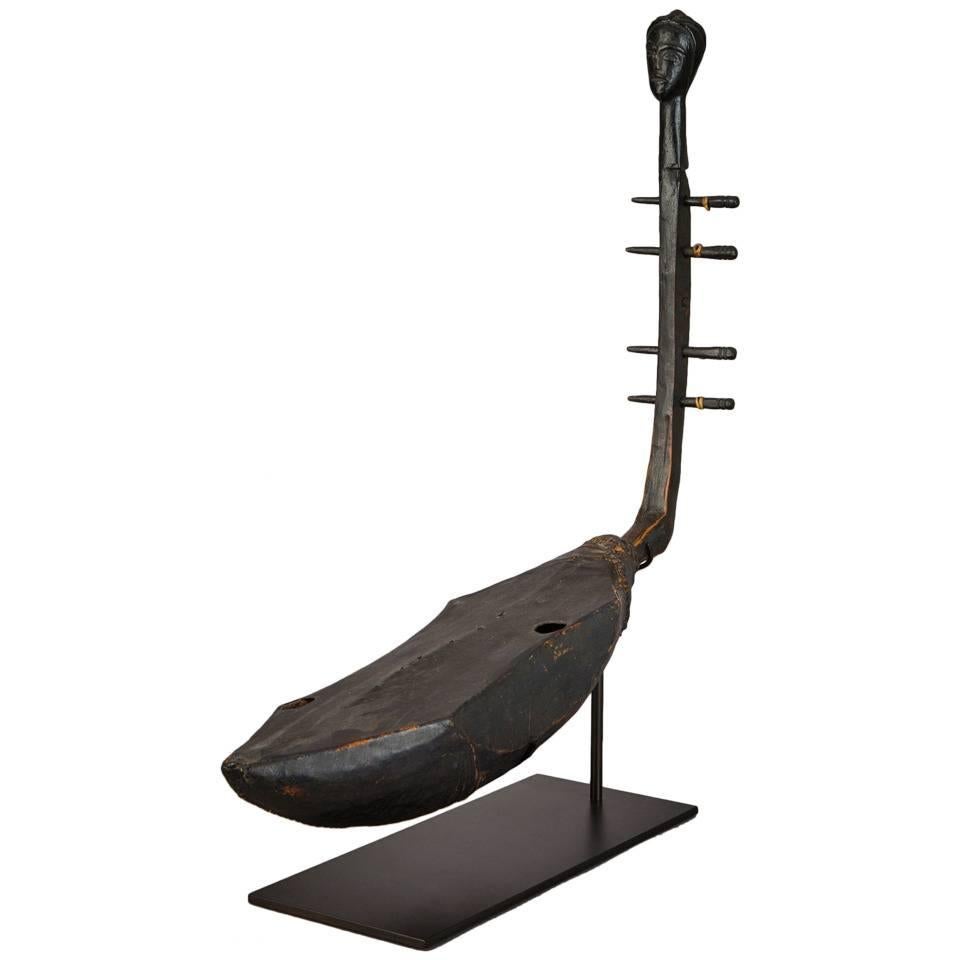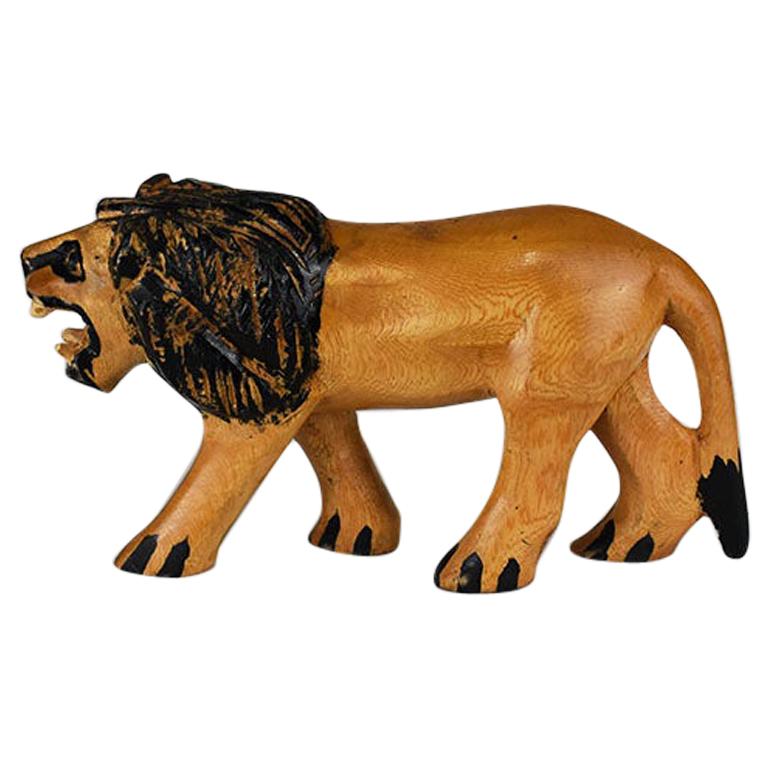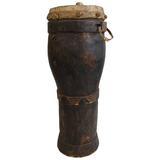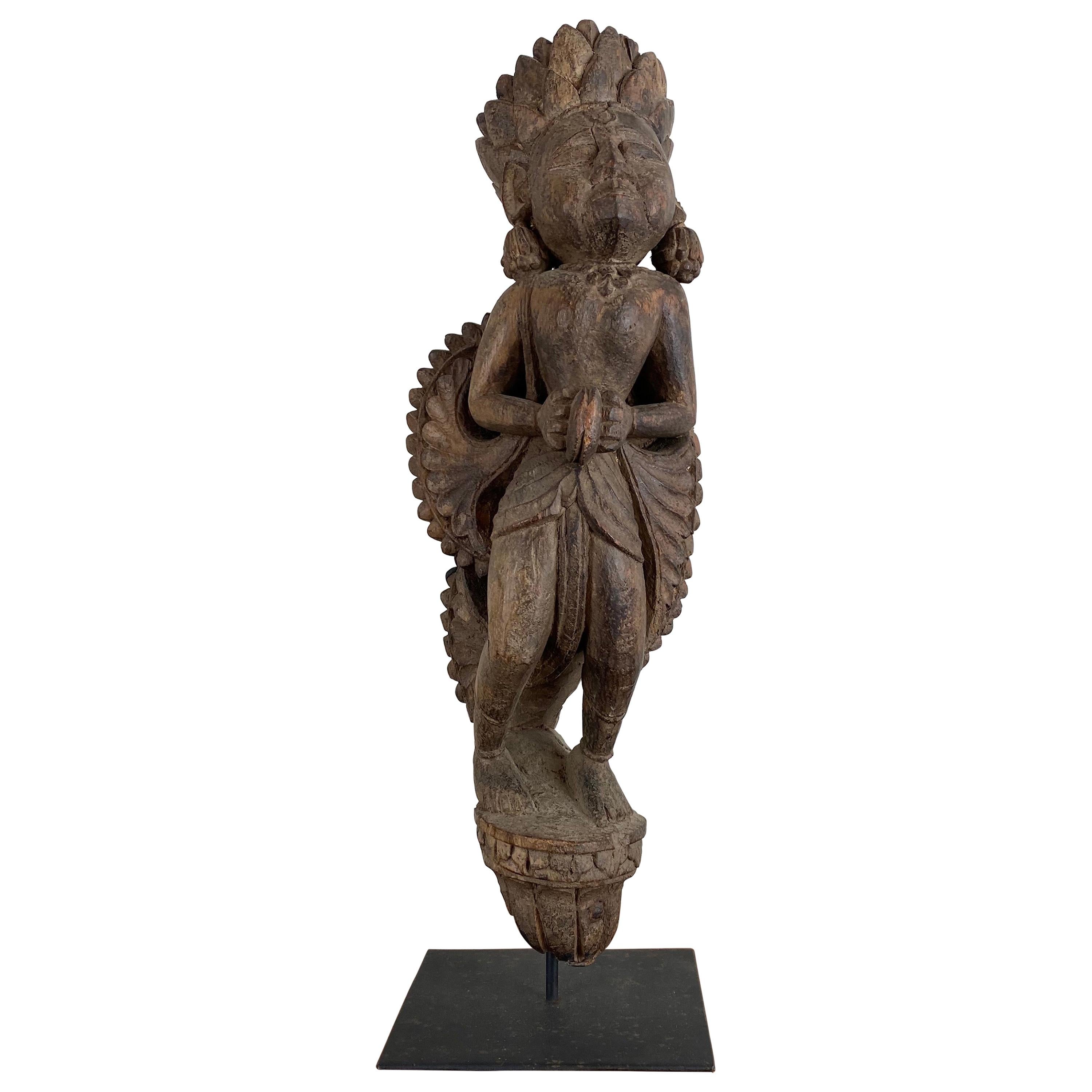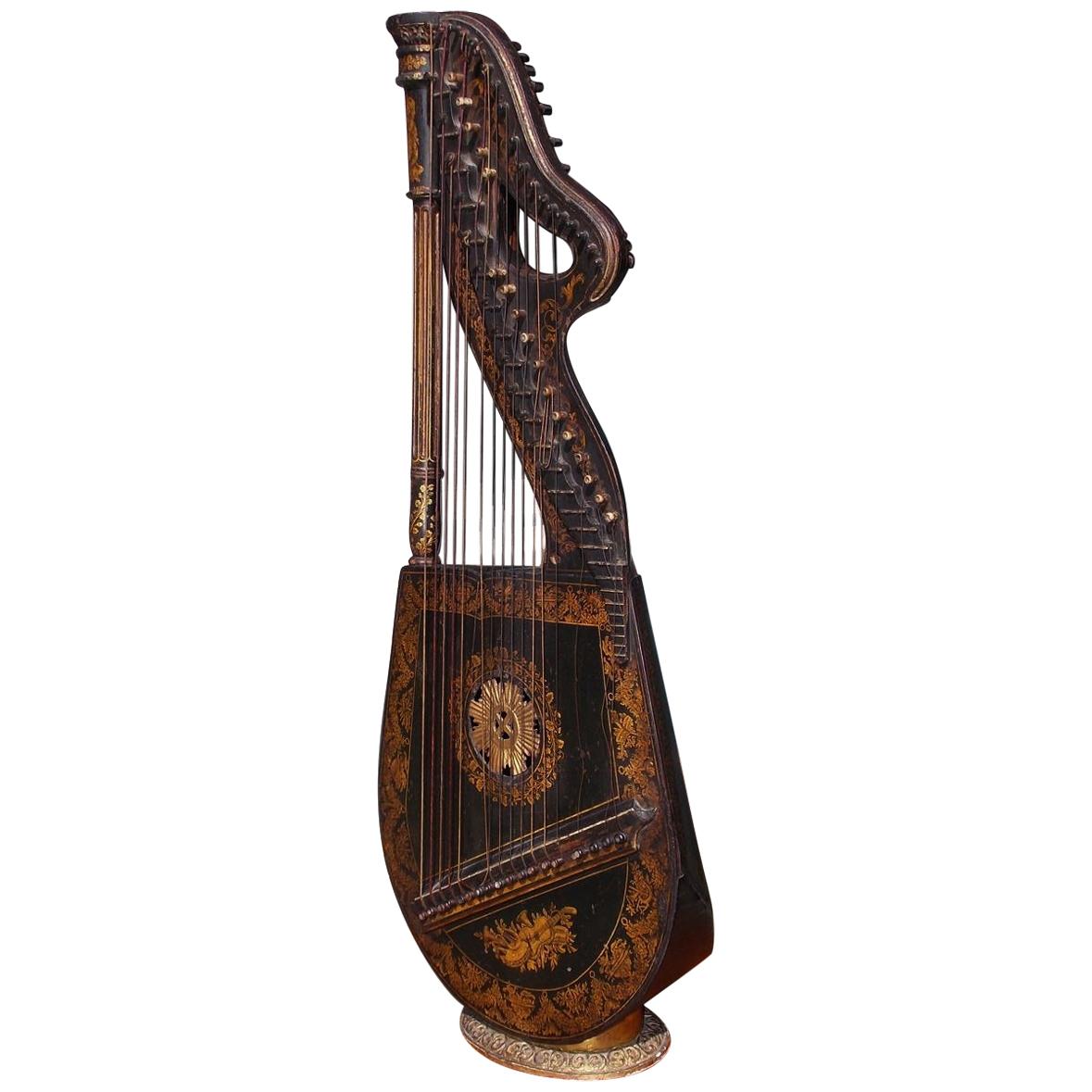Items Similar to African Mangbetu Carved Figural Fertility Bow Harp Domu Instrument 27"
Want more images or videos?
Request additional images or videos from the seller
1 of 13
African Mangbetu Carved Figural Fertility Bow Harp Domu Instrument 27"
About the Item
Rare vintage museum quality African Mangbetu fertility harp / domu, an African stringed instrument of the Mangbetu poeple, featuring a round wooden body, stretched red leather head with two sounding holes and four strings on pegs. Hand carved, in the shape of a wooden figure wearing a textured cloak or robe, flanked by two carved heads at the base of the instruments neck, which terminates in a fourth human face. Mauwotu.
Purchased from the collection of Paul Gotay. Paul is a recognized African art collector and Defense Attorney out of Nevada. His collections have been displayed in Salt Lake City as well as prominent museums and galleries across the US.
"The Mangbetu are a Central Sudanic ethnic group in the Democratic Republic of the Congo, living in the northeastern province of Haut-Uele. The Mangbetu are known for their highly developed art and music. One instrument associated with and named after them is the Mangbetu harp or guitar. The Mangbetu stood out to European colonists because of their elongated heads. Traditionally, babies' heads were wrapped tightly with cloth in order to give them this distinctive appearance. The practice, called Lipombo, began dying out in the 1950s with the arrival of more Europeans and westernization. Because of this distinctive look, it is easy to recognize Mangbetu figures in African art." (Source: Wikipedia)
"Mangbetu aristocrats surrounded themselves with a wide variety of finely crafted utilitarian objects such as boxes, jars, stools, musical instruments, and weapons, many of which feature figurative elements. The designs of musical instruments are especially beautiful examples of the ingenious amalgamation of a functional artifact and the human form. In more elaborately carved harps, the entire neck may be figurative. There is also considerable variation in the curvature of the bow and the angle of the neck's attachment to the resonator. The resonators come in two forms, the hourglass shape or an oval shape, and usually feature two small sounding holes on the top surface. A variety of animal skins were used to cover the resonator, including pangolin scales, okapi and leopard pelts, and snake and lizard skins. In ethnic groups related to the Mangbetu, the anthropomorphic convention is carried further and legs are carved below the resonator so that the body of the harp is also the body of the figure.
Mangbetu harps have been studied in depth as art objects; their musical use, however, remains largely unexplored. Although they appear in historical photographs from the region, these rarely show the harp being played. As the Mangbetu enthusiasm for carving continued and harps became increasingly figurative, the ability to appropriately string and tune the instruments became increasingly difficult. Before long, the importance of the harp as a musical instrument was replaced by its importance as an art object. This evolution led to instruments that were completely unplayable—with strings too close together, unusable tuning pegs, flattened sound boxes, etc.—but undoubtedly visually striking.
The harp first appeared in Mangbetu culture some time in the late nineteenth century, and reached its peak during the colonial period of the early twentieth century. Many believe that the initial practice of carving representations of human heads was adopted from the neighboring Azande peoples to the north. As cultural and musical traditions have changed over the years in Mangbetu culture, musical instruments have appeared and disappeared. Some Mangbetu elders claim that the heads of the harp represented Queen Nenzima and King Yangala, and that after their deaths the practice of that particular style gradually declined. Today, harps are no longer found in Mangbetu society." (Source: The Metrololitan Museum of Art)
Dimensions:
8.5" x 21" x 27" (Width x Depth x Height)
- Dimensions:Height: 27 in (68.58 cm)Width: 21 in (53.34 cm)Depth: 8.5 in (21.59 cm)
- Style:Tribal (In the Style Of)
- Materials and Techniques:
- Period:
- Date of Manufacture:Early 20th Century
- Condition:Wear consistent with age and use. Good Overall - Scuffs/wear/scrapes to wood; some dried out sections to leather head; needs new strings.
- Seller Location:Dayton, OH
- Reference Number:
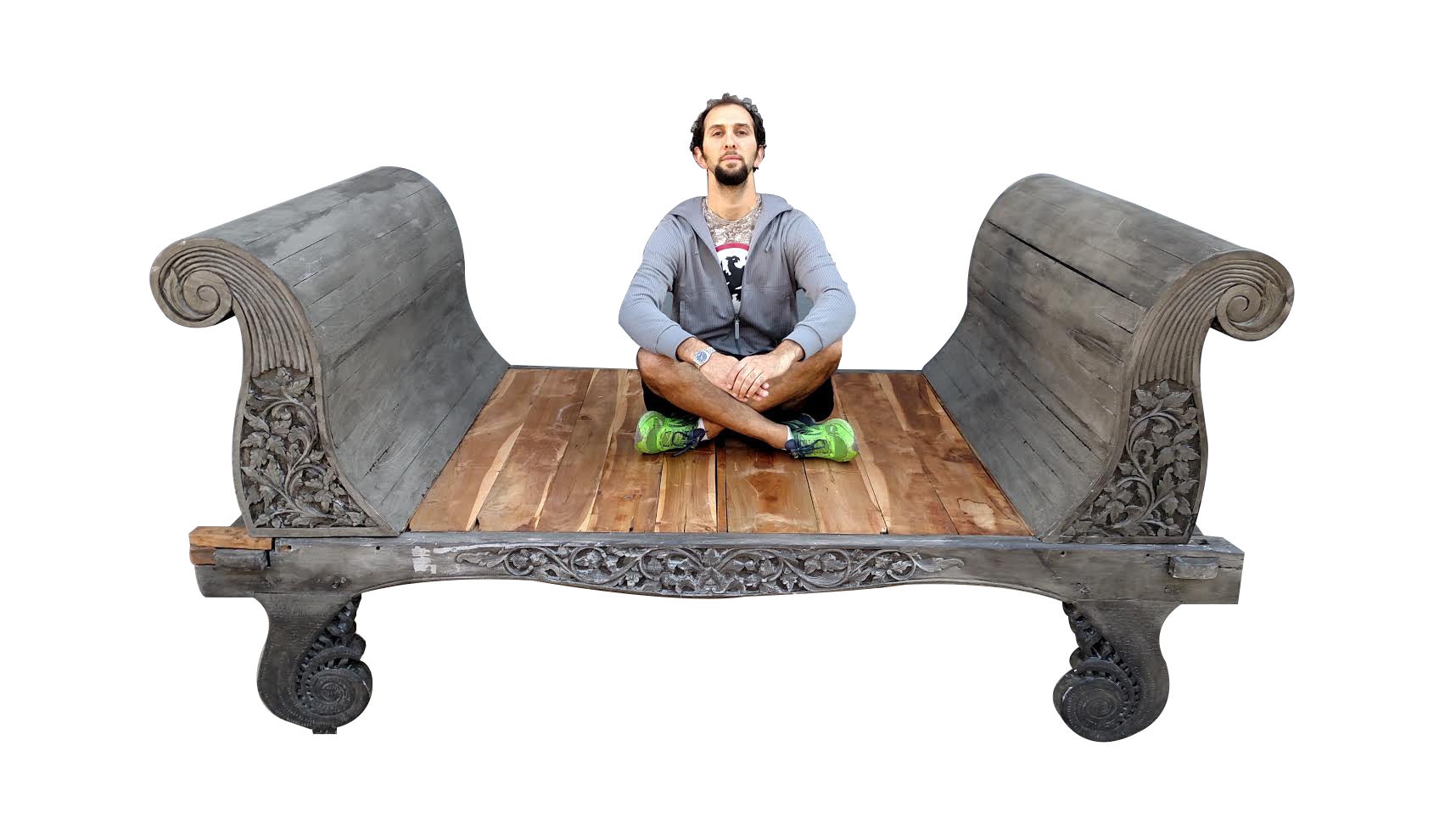
About the Seller
4.9
Platinum Seller
These expertly vetted sellers are 1stDibs' most experienced sellers and are rated highest by our customers.
Established in 2010
1stDibs seller since 2020
1,113 sales on 1stDibs
Typical response time: <1 hour
- ShippingRetrieving quote...Ships From: Dayton, OH
- Return PolicyA return for this item may be initiated within 2 days of delivery.
More From This SellerView All
- Figural Carved Tribal Fertility Slit Drum Phallus Bhuta Bali Red PaintedLocated in Dayton, OHVintage Indonesian hand carved wooden slit drum / tribal fertility figure painted in red and black with bells around it’s neck and open space in the torso to...Category
Mid-20th Century Tribal Sculptures and Carvings
MaterialsHardwood, Paint
- Vintage Thomson System Azimuth Nautical Navigation Instrument Circle & CaseLocated in Dayton, OHWWII Era Thomson System Azimuth Instrument and wooden storage / carrying case. An azimuth circle is a navigation instrument in the form of a ...Category
Vintage 1940s Nautical Objects
MaterialsMetal
- Monumental Antique English Brass Telescope Tripod Maritime Instrument NauticalLocated in Dayton, OHRare and genuine 19th century English Victorian brass telescope on tripod stand. Features amazing optics and a large adjustable base with spi...Category
Antique 19th Century Victorian Nautical Objects
MaterialsBrass
- Antique Victorian Bisque Doll Black African American Cloth BodyLocated in Dayton, OHUnique antique 19th century African American (possibly mulatto?) doll with bisque head and hands, molded boots and cropped hair style, and a cloth body dressed in a yellow dress.Category
Antique Late 19th Century Victorian Toys and Dolls
MaterialsCeramic, Fabric
- Vintage Native American Southwestern Navajo Beaded Hair Clip Bow Barrette 5"Located in Dayton, OHVintage Native American / Navajo seed bead hair clip / bow / barrette featuring a colorful floral theme with white, red, yellow, green, and blue. Purchased in the 1960s-1970s at Gil...Category
Mid-20th Century Native American Collectible Jewelry
MaterialsLeather, Beads
- Antique Nautical Maritime Ship Ocean Liner Steamship Shadowbox Diorama 27"Located in Dayton, OHAntique three dimensional folk art diorama portraying a steam boat / oceanliner / ship on a choppy sea. The model is set in a rectangular shadowbox with white trim and brown wood fr...Category
Early 20th Century Nautical Objects
MaterialsHardwood
You May Also Like
- Rare Gabonese African HarpLocated in New York, NYA rare figurative harp from made by the Vuvi or Tsogo people of Gabon. It is an instrument traditionally played by young men and boys. These rare instruments are well known for their...Category
20th Century Gabonese Tribal Art
MaterialsWood
- Hand Carved Wood Lion Toy Figure in Orange and Black, Africa, 1970sLocated in Oklahoma City, OKA whimsical hand carved lion statue from Africa. Hand carved by local artisans in East Africa in the 1970s, this wooden statue will be a great accen...Category
Vintage 1970s North African Tribal Sculptures and Carvings
MaterialsWood, Paint
- Collection of Ndebele Fertility DollsLocated in Mt Kisco, NYA group of six collected Ndebele hand beaded fertility dolls of various sizes and designs. The dolls are made in secret by the maternal grandmother of ...Category
20th Century African Tribal Toys and Dolls
MaterialsBeads
- Early African Cuica Drum, Tribal Sculpture, Hand Carved WoodLocated in Buffalo, NYDrums are among the most important art forms in Africa, used both as a musical instrument and as a work of sculpture significant in many ceremonial functions, including dance, ritual...Category
20th Century Congolese Tribal Musical Instruments
MaterialsAnimal Skin, Wood
- Antique Hand-Carved Krishna FigureLocated in Raleigh, NCCarved wood Krishna figure with detailed feathers and form. Simple and peaceful. free shipping.Category
Early 20th Century Asian Religious Items
MaterialsHardwood
- English Regency Gilt Figural and Ebonized Dital Harp, Maker E. Light, Circa 1815Located in Hollywood, SCEnglish Regency gilt stenciled figural and floral ebonized dital harp signed by maker Edward Light. Retailed at Srohl Foley place London, Early 19th century.Category
Antique 1810s English Regency Musical Instruments
MaterialsWood, Ebony, Giltwood, String
